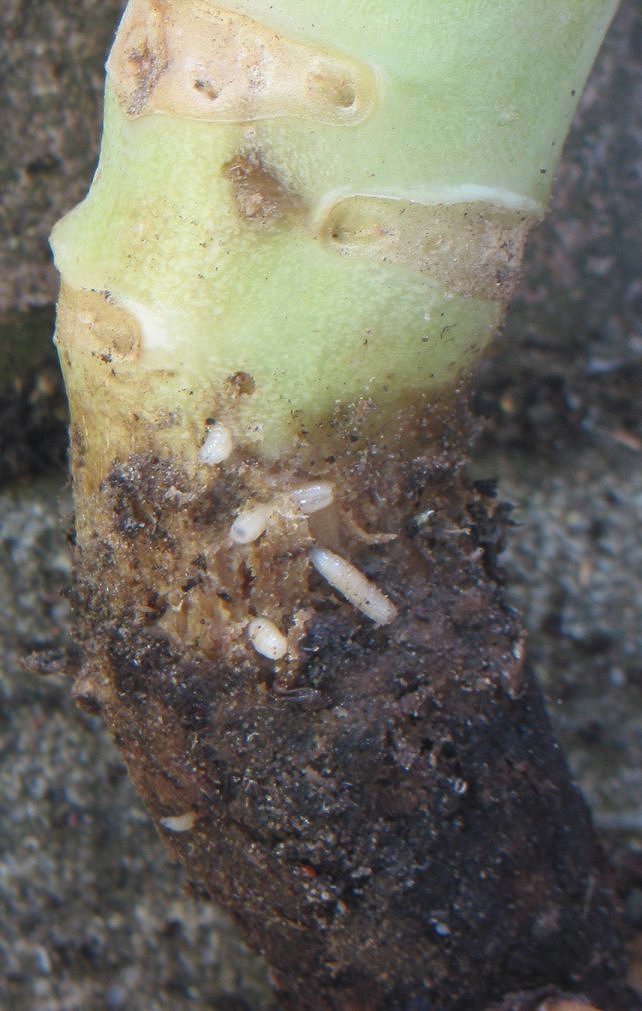Cabbage root fly on:
[Wikipedia]
[Google]
[Amazon]
''Delia radicum'', known variously as the cabbage fly, cabbage root fly, root fly or turnip fly, is a
 The first sign of the presence of the larvae is a delay in plant growth accompanied by the withering of leaves which develop a bluish tinge. The larvae are found on cabbage, turnip, swede, radish, and other cruciferous crops. Sometimes, 300 larvae can be found on one plant, damaging the inner parts of the main root and disrupting the transport of water and nutrients to the stem and leaves causing the death of many plants.
The first sign of the presence of the larvae is a delay in plant growth accompanied by the withering of leaves which develop a bluish tinge. The larvae are found on cabbage, turnip, swede, radish, and other cruciferous crops. Sometimes, 300 larvae can be found on one plant, damaging the inner parts of the main root and disrupting the transport of water and nutrients to the stem and leaves causing the death of many plants.
pest
Pest or The Pest may refer to:
Science and medicine
* Pest (organism), an animal or plant deemed to be detrimental to humans or human concerns
** Weed, a plant considered undesirable
* Infectious disease, an illness resulting from an infection
** ...
of crops
A crop is a plant that can be grown and harvested extensively for profit or subsistence. When the plants of the same kind are cultivated at one place on a large scale, it is called a crop. Most crops are cultivated in agriculture or hydroponi ...
. The larvae of the cabbage root fly are sometimes known as the cabbage maggot or root maggot. The adult flies are about 1 cm long and are grey in colour, but otherwise resemble the common house fly
The housefly (''Musca domestica'') is a fly of the suborder Cyclorrhapha. It is believed to have evolved in the Cenozoic Era, possibly in the Middle East, and has spread all over the world as a commensal of humans. It is the most common fly ...
.
The flies can be found all over Europe. After overwintering as pupa
A pupa ( la, pupa, "doll"; plural: ''pupae'') is the life stage of some insects undergoing transformation between immature and mature stages. Insects that go through a pupal stage are holometabolous: they go through four distinct stages in their ...
e in the soil
Soil, also commonly referred to as earth or dirt, is a mixture of organic matter, minerals, gases, liquids, and organisms that together support life. Some scientific definitions distinguish ''dirt'' from ''soil'' by restricting the former ...
, the flies emerge in spring, feed on nectar, and lay eggs close to plants of the genus
Genus ( plural genera ) is a taxonomic rank used in the biological classification of living and fossil organisms as well as viruses. In the hierarchy of biological classification, genus comes above species and below family. In binomial n ...
''Brassica
''Brassica'' () is a genus of plants in the cabbage and mustard family (Brassicaceae). The members of the genus are informally known as cruciferous vegetables, cabbages, or mustard plants. Crops from this genus are sometimes called ''cole ...
''. The eggs are white and about 1 mm in diameter. They hatch into white maggot
A maggot is the larva of a fly (order Diptera); it is applied in particular to the larvae of Brachycera flies, such as houseflies, cheese flies, and blowflies, rather than larvae of the Nematocera, such as mosquitoes and crane flies.
E ...
s after about six days and the larva
A larva (; plural larvae ) is a distinct juvenile form many animals undergo before metamorphosis into adults. Animals with indirect development such as insects, amphibians, or cnidarians typically have a larval phase of their life cycle.
Th ...
e feed for about three weeks on the roots and stems of the cabbage plants. After this, the larvae are typically 0.9 to 1 cm in length and form reddish-brown pupae which hatch into adult flies after around 20 days. This species is univoltine
Voltinism is a term used in biology to indicate the number of broods or generations of an organism in a year. The term is most often applied to insects, and is particularly in use in sericulture, where silkworm varieties vary in their voltinism.
...
(has one generation per year) in northern Europe and bi- or trivoltine in central Europe.
Economic significance
 The first sign of the presence of the larvae is a delay in plant growth accompanied by the withering of leaves which develop a bluish tinge. The larvae are found on cabbage, turnip, swede, radish, and other cruciferous crops. Sometimes, 300 larvae can be found on one plant, damaging the inner parts of the main root and disrupting the transport of water and nutrients to the stem and leaves causing the death of many plants.
The first sign of the presence of the larvae is a delay in plant growth accompanied by the withering of leaves which develop a bluish tinge. The larvae are found on cabbage, turnip, swede, radish, and other cruciferous crops. Sometimes, 300 larvae can be found on one plant, damaging the inner parts of the main root and disrupting the transport of water and nutrients to the stem and leaves causing the death of many plants.
References
{{DEFAULTSORT:Delia Radicum Anthomyiidae Agricultural pest insects Flies described in 1758 Diptera of Europe Taxa named by Carl Linnaeus